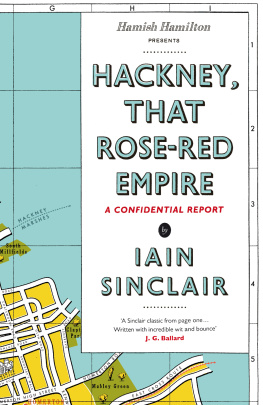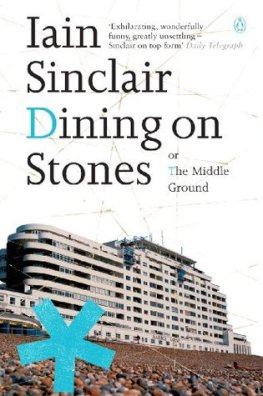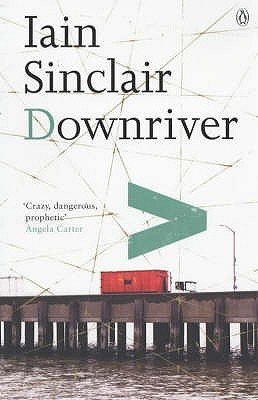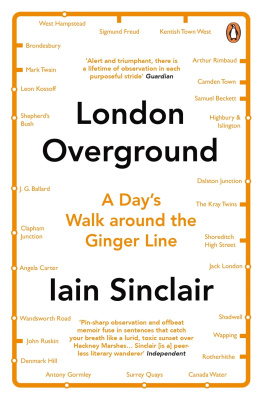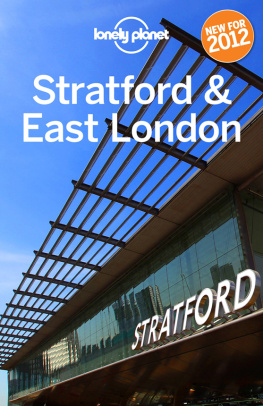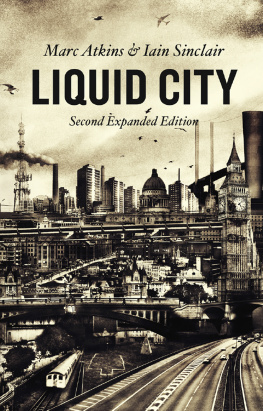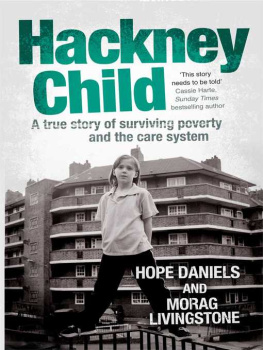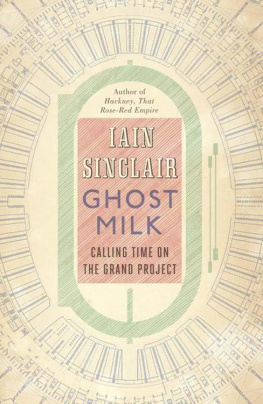Hackney, That Rose-Red Empire
A Confidential Report
IAIN SINCLAIR
With original prints and drawings by
OONA GRIMES
HAMISH HAMILTON
an imprint of
PENGUIN BOOKS
HAMISH HAMILTON
Published by the Penguin Group
Penguin Books Ltd, 80 Strand, London WC2R 0RL England
Penguin Group (USA) Inc., 375 Hudson Street, New York, New York 10014, USA
Penguin Group (Canada), 90 Eglinton Avenue East, Suite 700, Toronto, Ontario, Canada M4P 2Y3 (a division of Pearson Penguin Canada Inc.)
Penguin Ireland, 25 St Stephens Green, Dublin 2, Ireland (a division of Penguin Books Ltd)
Penguin Group (Australia), 250 Camberwell Road, Camberwell, Victoria 3124, Australia (a division of Pearson Australia Group Pty Ltd)
Penguin Books India Pvt Ltd, 11 Community Centre, Panchsheel Park, New Delhi 110 017, India
Penguin Group (NZ), 67 Apollo Drive, Rosedale, North Shore 0632, New Zealand (a division of Pearson New Zealand Ltd)
Penguin Books (South Africa) (Pty) Ltd, 24 Sturdee Avenue, Rosebank, Johannesburg 2196, South Africa
Penguin Books Ltd, Registered Offices: 80 Strand, London, WC2R 0RL, England
www.penguin.com
First published 2009
Copyright Iain Sinclair, 2009
Prints and drawings copyright Oona Grimes, 2009
The constitute an extension of this copyright page
The moral right of the author has been asserted
All rights reserved
Without limiting the rights under copyright reserved above, no part of this publication may be reproduced, stored in or introduced into a retrieval system,or transmitted, in any form or by any means (electronic, mechanical, photocopying, recording or otherwise), without the prior written permission of both the copyright owner and the above publisher of this book
ISBN: 978-0-14-193099-2
By the Same Author
FICTION
White Chappell, Scarlet Tracings Downriver
Radon Daughters
Slow Chocolate Autopsy (with Dave McKean)
Landors Tower White Goods
Dining on Stones
DOCUMENTARY
The Kodak Mantra Diaries
Lights Out for the Territory
Liquid City (with Marc Atkins)
Rodinskys Room (with Rachel Lichtenstein)
Crash (on Cronenberg/Ballard fi lm)
DarkLanthorns
Sorry Meniscus
London Orbital: A Walk around the M25
The Verbals (interview with Kevin Jackson)
Edge of the Orison
London: City of Disappearances (editor)
POETRY
Back Garden Poems
Muscats Wrm
The Birth Rug
Lud Heat
Suicide Bridge
Flesh Eggs & Scalp Metal: Selected Poems
Jack Elams Other Eye
Penguin Modern Poets 10
The Ebbing of the Kraft
Conductors of Chaos (editor)
Saddling the Rabbit
The Firewall: Selected Poems
Buried at Sea
i.m. Bill Griffiths, Ian Breakwell, Paul Burwell
THE CYCLE
Geography is destiny.
James Ellroy
London Fields
We are the rubbish, outmoded and unrequired. Dumped on wet pavings and left there for weeks, in the expectation of becoming art objects, a baleful warning. Nobody pays me to do this. It is my own choice, to identify with detritus in a place that has declared war on unconvinced recyclers while erecting expensive memorials to the absence of memory. This is a borough that has dedicated itself to obliterating the meaning of shame.
I am coming west off the avenue, under a canopy of London plane trees old enough to appear in sepia postcards: coming home, at the end of an afternoon walk. Councils of sleek crows. Magpies imitating road drills. Its a habit I cant break, the habit of Hackney: writing and walking, thirty years in one house. Thirty years of misreading the signs, making fictions: with a bounce in the step, cartilage audibly complaining, like the electric coffeegrinder our children remember. And we have forgotten. Five miles of canal bank, Victoria Park, heights of Homerton; running over the days work, halfnoticing revisions in the fabric of things. But returning always, as light fails, to the same kitchen, a meal in preparation. The undervalued dispensation of domestic life.
Lines of trees outrank us, their bulk is astonishing. Skins encrusted with witness: patches of green over grey, over fleshy orange. Scars, carcinogenic lumps. Hawser roots suck at dirt. The avenues have been set, as we discover from old maps, in strict patterns, an arcane geometry. Aisles of grappling NeoRomantic branches. A blood meadow: London Fields. Public ground for the fattening of herds and flocks, Norfolk geese, before they are driven, by very particular routes, to Smithfield slaughter. Chartered markets service drovers, incomers. They exist to peddle plunder and to fleece the unwary.
Ive grown quite fond, lately, of that sculpture, a civic intervention, at the southeast corner of the Fields, near the drinkers table; across from Sheep Lane and Beck Road, where the officialunofficial artists live. The professional alcoholics, out at first light, string dogs and blue bags, act as courtiers to a lifeless Pearly King and Queen; who sit, silent witnesses to so much agitation and hallucinatory folly. Crowned with bowler hats, eyes made red, they offer dishes of fruit from generous laps. A frozen tide encloses them, seapebbles, pebbledash. Mosaic altars have been decorated by schoolkids: lobsters, flying fish, crabs. In beds of lavender. Buddhas of the city, the statues survive, untargeted by fundamentalists, iconoclasts. The oracular indifference of this rounded couple is a virtue. They are assembled from chips and splinters of bright tile: reconstituted damage. The ruins of demolished terraces, which once ran to the edge of the Fields, have formed themselves into twinned, male and female, votive presences. They are authentically regal, divinely righteous, impervious to bribes or flattery. And they have adapted, graciously, to where they are, among rippling concrete dunes, troughs of hardy perennials, a backdrop of public housing. A small flock of grey sheep attend them, backs mossy with velvet. The whole tableau, its origins obscure, is being quietly absorbed into nature: economic migrants from an Antoni Gaud theme park. As a visiting, overbright student said to me.
Going west, I dodge through the stutter of evening traffic and into Shrubland Road, at the point where it splits off into Albion Drive. A French culture pundit, digital camera in hand, tracking across from the nearest Underground station which is not so near was excited by the faded sign hanging outside the doomed public house, the Havelock. Plenty of Hackney oldtimers, I discover as I conduct interviews for this book, navigate their memoryterrain by way of pubs. Do you remember? Being on firstname terms with the vampire landlady? Crowblack fright wig, purple talons, heavy gold manacles on thin wrist. Villainies of yesteryear: smoked ghosts propping up afternoon bars, sentimental about dead gangsters, shoplifting grannies. Holloway Nan. Shirley Pitts. Or revived literary societies in back rooms? Politics, conspiracies, pool. The Havelock is an anachronism. The coalfire fug, dirty glasses and recidivist linoleum. These old brown boozers are London fictions in embryo, waiting for the right ventriloquist: Patrick Hamilton, Derek Raymond, T. S. Eliot. Listening is also writing. First the pubs, then the petrol stations: they are declared redundant.

